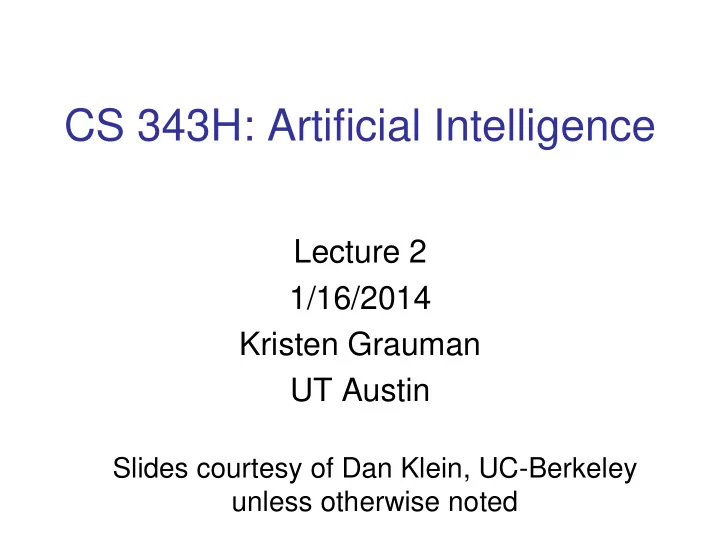

CS 343H: Artificial Intelligence Lecture 2 1/16/2014 Kristen Grauman UT Austin Slides courtesy of Dan Klein, UC-Berkeley unless otherwise noted
Logistics Questions about the syllabus? Textbook Assignment PS0 Mailing list and Piazza
Color game
What is AI? The science of making machines that: Think like humans Think rationally Act like humans Act rationally
Thinking Like Humans? The cognitive science approach: 1960s ``cognitive revolution'': information-processing psychology replaced prevailing orthodoxy of behaviorism Scientific theories of internal activities of the brain What level of abstraction? “Knowledge'' or “circuits”? Cognitive science: Predicting and testing behavior of human subjects (top-down) Cognitive neuroscience: Direct identification from neurological data (bottom-up) Both approaches now distinct from AI Both share with AI the following characteristic: The available theories do not explain (or engender) anything resembling human-level general intelligence Images from Oxford fMRI center
What is AI? The science of making machines that: Think like humans Think rationally Act like humans Act rationally
Acting Like Humans? Turing (1950) “Computing machinery and intelligence” “Can machines think?” “Can machines behave intelligently?” Operational test for intelligent behavior: the Imitation Game Predicted by 2000, a 30% chance of fooling a lay person for 5 minutes Anticipated all major arguments against AI in following 50 years Suggested major components of AI: knowledge, reasoning, language understanding, learning Problem: Turing test is not reproducible or amenable to mathematical analysis
What is AI? The science of making machines that: Think like humans Think rationally Act like humans Act rationally
Thinking Rationally? The “Laws of Thought” approach What does it mean to “think rationally”? Normative / prescriptive rather than descriptive Logicist tradition: Logic: notation and rules of derivation for thoughts Aristotle: what are correct arguments/thought processes? Direct line through mathematics, philosophy, to modern AI Problems: Not all intelligent behavior is mediated by logical deliberation What is the purpose of thinking? What thoughts should I (bother to) have? Logical systems tend to do the wrong thing in the presence of uncertainty
What is AI? The science of making machines that: Think like humans Think rationally Act like humans Act rationally
Acting Rationally Rational behavior: doing the “right thing” The right thing: that which is expected to maximize goal achievement, given the available information Doesn't necessarily involve thinking, e.g., blinking Thinking can be in the service of rational action Entirely dependent on goals! Irrational ≠ insane, irrationality is sub -optimal action Rational ≠ successful Our focus here: rational agents Systems which make the best possible decisions given goals, evidence, and constraints In the real world, usually lots of uncertainty … and lots of complexity Usually, we’re just approximating rationality “Computational rationality”
Acting Rationally Maximize your expected utility.
What about the brain? Brains (human minds) are very good at making rational decisions (but not perfect) Brains aren’t as modular as software “Brains are to intelligence as wings are to flight” Lessons learned: prediction and simulation are key to decision making
Designing Rational Agents An agent is an entity that perceives and acts . Agent A rational agent selects Sensors Percepts actions that maximize its Environment utility function . ? Characteristics of the percepts, environment, and action space dictate Actuators techniques for selecting Actions rational actions. This course is about: General AI techniques for a variety of problem types Learning to recognize when and how a new problem can be solved with an existing technique
Color game You, as a class, acted as a learning agent Actions: Observations: Goal:
Properties of task environment Fully observable vs. partially observable Single-agent vs. multi-agent Deterministic vs. non-deterministic Episodic vs. sequential Static vs. dynamic Discrete vs. continuous Known vs. unknown
Example intelligent agents
Pacman as an Agent Agent Sensors Percepts Environment ? Actuators Actions
Reflex Agents Reflex agents: Choose action based on current percept (and maybe memory) May have memory or a model of the world’s current state Do not consider the future consequences of their actions Consider how the world IS Can a reflex agent be rational? [demo: reflex optimal / loop ]
Planning Agents Plan ahead Ask “what if” Decisions based on (hypothesized) consequences of actions Must have a model of how the world evolves in response to actions Consider how the world WOULD BE
Reminders • PS0 Python Tutorial is due Thurs 1/23 • See course website for next week’s reading • Next email response due Mon 8 pm
Recommend
More recommend